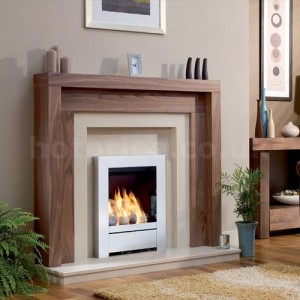Guest Post from hotprice.co.uk
First things first, this is not a do it yourself gas installation guide.?It is against the law to carry out any work on gas if you are not qualified to do so. For all fire and fireplace installations it is highly recommend that you use a professional installer who is competent and has the correct qualifications.
Getting The Right Professional
 For Gas fire installations you can turn to the Gas Safe Register, whilst solid fuel installations it is HETAS. However be careful ? whilst the professional may have the correct qualification, they may not be a great builder.
For Gas fire installations you can turn to the Gas Safe Register, whilst solid fuel installations it is HETAS. However be careful ? whilst the professional may have the correct qualification, they may not be a great builder.
Installing a fire or fireplace is 90% building work, normally involving building work to the correct size and plastering. Please do not fall into the trap of buying a new fire and getting it fitted by a friends friend who is Gas Safe registered, that qualification could translate to meaning nothing. He or she may never have picked up a trowel or a spirit level before. Ask to see examples of the previous work they have done.
Is Your New Fireplace?Compatible?
The first thing to consider when installing gas fires?/ fireplaces is the product itself. Is it compatible with the flue requirements and room in which it will go? If in doubt, before purchasing get a professional to do survey even if it means paying for it. ?Once you have attempted to fit an appliance and then you realise it?s not suitable it is deemed as second hand from the supplier, and non-returnable.
What Condition Is The Chimney In?
The first job is to check the integrity of the flue. Has your flue been swept? This is a legal requirement if your chimney has ever burnt solid fuel. It must be swept before a new gas appliance can be installed. It is good practise to have the flue swept whether solid fuel has been burnt in it or not as a bird could have nested and blocked off the flue.
Depending on whether you are doing a gas or solid fuel installation the flue flow test is slightly different for both, but is basically carried out using smoke pellets. The length of the flue must be checked whilst the smoke pellet is lit, including bedrooms, loft and chimney stack. Smoke must emit from one terminal/chimney pot only and must not leak through any brickwork, floors or skirting boards etc. If the flue is sound, the installation can continue. we move on. If you are installing a gas appliance the system must be checked and the gas turned off.
Preparing The Area
Under normal circumstances the following procedures will apply:
- Alter the gas pipes to suit the new appliance
- Create the correct size opening for the new fireplace
- Fit a lintel if necessary
- Re-plaster the walls if required. Note that some appliances require plastering whilst the appliance installation is in progress.
The Hearth
If you are fitting a new hearth now would be the time to do it. It must be centred to the builders opening and centre of the chimney breast. You?ll want to make sure it is level and supported from underneath using sand and cement.?Obviously you?ll want things perfectly level because everything sits on it and it could look uneven.
A tip if you are fitting a limestone fireplace: put plastic sheeting over the sand and cement so it doesn?t bleed through the limestone hearth.
The Fireplace Surround
Place the back panel into position. Offer your fire surround onto the hearth and in front of the back panel and measure and secure it to the wall using the hearth as a guide for centering. With the surround secured in place the back panel can now be pulled forward, use off cuts of masonry to wedge the back panel?tight against the rebate of the surround.
You now have a small gap in between the builders opening and the back panel; this gap must be filled to create a gas tight seal so the fire can only pull into the flue. Sand and cement can be used.
Two useful tips:
- Fill the gap with wire mesh. A product called Brick Taw is good for this purpose
- Before filling, add a little lime to the mix to make it sticky.
Now everything is sealed you can fit the actual appliance, and again specific manufacturers instructions must be referred to. Once the appliance is installed the gas system in the house must be tested for tightness and the appliance itself tested for spillage, standing pressure, working pressure and gas rated.
?
There is a wide range of varying style fireplaces on the market today but these basic principles will always apply, irrelevant of the product.
Of course, safety checks are compulsory each and every time so to ensure the appliance works correctly and safely, giving you years of good service and enjoyment.
The long and short is, whatever fireplace you choose, have it done properly by an experienced professional. With the help of this guide you should be able to understand the intricacies of what?s involved and what is going on when you do have your new fireplace installed.
Source: http://www.ukhomeimprovement.co.uk/considering-a-gas-fire-installation/
9/11 ground zero world trade center university of michigan university of michigan nadal murray cyndi lauper
No comments:
Post a Comment
Note: Only a member of this blog may post a comment.